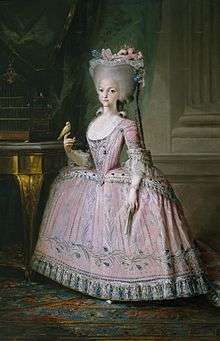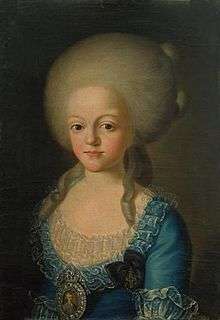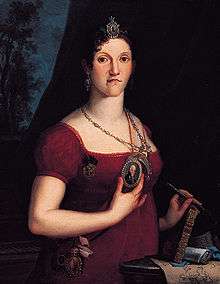Carlota Joaquina of Spain
| Carlota Joaquina | |||||
|---|---|---|---|---|---|
 Portrait by
Mariano Salvador Maella | |||||
| Queen consort of the United Kingdom of Portugal, Brazil and the Algarves | |||||
| Tenure | 20 March 1816 – 7 September 1822 | ||||
| Queen consort of Portugal and the Algarves | |||||
| Tenure | 7 September 1822 – 10 March 1826 | ||||
| Empress consort of Brazil | |||||
| Titular | 15 November 1825 – 10 March 1826 | ||||
| Born |
25 April 1775 Palace of Aranjuez, Aranjuez, Spain | ||||
| Died |
7 January 1830 (aged 54) Palace of Queluz, Sintra, Portugal | ||||
| Burial | Pantheon of the Braganzas, Lisbon, Portugal | ||||
| Spouse |
João VI of Portugal (m. 1785; d. 1826) | ||||
| Issue see details... | |||||
| |||||
| House | Bourbon | ||||
| Father | Carlos IV of Spain | ||||
| Mother | Maria Luisa of Parma | ||||
| Religion | Roman Catholicism | ||||
Doña Carlota Joaquina of Spain (Carlota Joaquina Teresa Cayetana; 25 April 1775 – 7 January 1830) was a Queen consort of Portugal as wife of John VI, Infant of Spain, Infant consort of Portugal, Princess consort of Brazil, Princess regent consort of Portugal and Queen consort of the United Kingdom of Portugal, Brazil and Algarves. She was the eldest daughter and surviving child of King Charles IV of Spain and his wife Maria Luisa of Parma.
Early life

She was born in Aranjuez during the reign of her paternal grandfather, Charles III of Spain, the eldest surviving child born to her parents. Her father was the second son of Charles III and his wife Maria Amalia of Saxony; her mother, Maria Luisa of Parma was a granddaughter of Louis XV of France through her mother Princess Louise Élisabeth of France. Louise Élisabeth's husband Philip, Duke of Parma, was a younger brother of Charles III. Carlota Joaquina's future husband was a grandson of Mariana Victoria of Spain, sister of Charles III and the Duke of Parma.
The subject of Carlota Joaquina's marriage was arranged by Mariana Victoria and Charles III in the late 1770s when Mariana went to Spain to encourage diplomatic relations between the estranged countries. Carlota Joaquina was to marry the future John VI of Portugal (at that time only an Infante of Portugal), and Carlota Joaquina's uncle Infante Gabriel was to marry the Infanta Mariana Vitória of Portugal, another grandchild of Mariana Victoria of Spain.
Marriage
On 8 May 1785 Carlota Joaquina was officially married to the future John VI, King of Portugal, Brazil and the Algarves, the second son of Queen Maria I of Portugal and the late King Peter III of Portugal. The marriage was not consummated until 9 January 1790.

In 1788, when his eldest brother Joseph, Prince of Brazil, died, John became the first in line to his mother's throne. Soon he received the titles Prince of Brazil and 15th Duke of Braganza. Between 1788 and 1816, Carlota Joaquina was known as Princess of Brazil. John, her husband, was good-natured, indolent, corpulent and almost as ugly as she was. His religious observances bored her, and they were quite incompatible. Nevertheless, they produced nine children and, because they were all handsome, it was rumoured that especially the younger ones had a different father. After the birth of the ninth child they began to live separate lives, he at Mafra Palace and she at Queluz Palace or Ramalhão Palace. Here it was rumoured that she had bought a retreat where she indulged in sexual orgies.
In 1807, the Portuguese royal family left Portugal for Brazil because of the Napoleonic invasion.
In Brazil
While in Brazil, Carlota Joaquina made attempts to obtain the administration of the Spanish dominions in Hispanic America, a project known as Carlotism. Spain itself was controlled by Napoleon and its kings, her father and brother Ferdinand, were held by Napoleon in France. Carlota Joaquina regarded herself as the heiress of her captured family. Allegedly among her plans was to send armies to occupy Buenos Aires and northern Argentina to style herself "Queen of La Plata". The Portuguese-Brazilian forces, however, only managed to annex the eastern banks of the Rio de la Plata as Cisplatina, which were kept in the Empire of Brazil after 1822 and seceded in 1828 as the Republic of Uruguay.
Queen
When the Portuguese royal family returned to Portugal in 1821 after an absence of 14 years, Carlota Joaquina met a country that had changed much since their departure. In 1807, Portugal had lived stably under absolutism. Napoleonic troops and political attitudes fostered by the Cádiz Cortes in Spain had brought revolutionary ideas to Portugal. In 1820, a liberal revolution commenced in Oporto. A constitutional Cortes Gerais had been promulgated, and in 1821 it gave Portugal its first constitution. The queen had arch-conservative positions and wanted a reactionary response in Portugal. Her husband, however, did not want to renege on his vows to uphold the constitution. Carlota Joaquina made an alliance with her youngest son Miguel, who shared his mother's conservative views. In 1824, using Miguel's position as army commander, they took power and held the king a virtual prisoner in the palace, where the queen tried to make him abdicate in favor of Miguel. The king received British help against his wife and son and regained power, finally compelling his son to leave the country. The queen had also to go briefly into exile.
King John VI lived in Bemposta Palace and Queen Carlota Joaquina in Queluz. Though she lived there quietly, she became decidedly eccentric in dress and behaviour. However, their eldest son Pedro, left behind as regent in Brazil, was proclaimed and crowned on 1 December 1822 as its independent Emperor. John VI refused to accept this until he was persuaded by the British to do so, signing in August 1825 the Treaty of Rio de Janeiro by which he and Carlota Joaquina were granted the honorific title of Emperors of Brasil.[1] He died in March 1826. Claiming ill-health, Carlota Joaquina refused to visit his deathbed and started the rumour that her husband had been poisoned by the Freemasons.
Pedro, Emperor of Brazil, now became King of Portugal as well, but knowing that carrying out the duties of both positions would be impossible, Pedro abdicated in Portugal and made his eldest daughter Maria the Queen of Portugal as well as betrothing her to Miguel, his younger brother. In the meantime, Carlota Joaquina's daughter, the Infanta Isabel Maria was to be Regent in Portugal instead of Carlota Joaquina, who ordinarily would have held such a post as Queen Dowager. About two years later the little queen set out for Portugal, only to find upon arrival at Gibraltar that her uncle and fiancé had not only removed the regent, but declared himself King of Portugal.
Queen Carlota Joaquina died at the Queluz Royal Palace, outside of Sintra. It is speculated whether she died because of natural causes or whether she, in fact, killed herself.
Issue
Carlota Joaquina married King João VI of Portugal in 1785 and had several children
| Name | Birth | Death | Notes |
|---|---|---|---|
| Maria Teresa, Princess of Beira | 29 April 1793 | 17 January 1874 | Married first her cousin Pedro Carlos de Borbón y Bragança, Infante of Spain and Portugal and second to Carlos, Infante of Spain, widower of her sister Maria Francisca. |
| Francisco António, Prince of Beira | 21 March 1795 | 11 June 1801 | Died at the age of 6, making his younger brother, Pedro, the heir to the throne of Portugal. |
| Infanta Maria Isabel | 19 May 1797 | 26 December 1818 | Married Ferdinand VII, King of Spain. |
| Peter IV of Portugal, I of Brazil | 12 October 1798 | 24 September 1834 | Stayed in Brazil after Napoleonic Wars in Spain. Proclaimed the Independence of Brazil in 1822 and became its first monarch as Emperor Peter I. He was also King of Portugal as Peter IV in 1826. |
| Infanta Maria Francisca | 22 April 1800 | 4 September 1834 | Married Carlos, Infante of Spain (his first marriage). |
| Infanta Isabel Maria | 4 July 1801 | 22 April 1876 | served as regent of Portugal from 1826 to 1828; died unmarried |
| Miguel I | 26 October 1802 | 14 November 1866 | Known by the Liberals as the Usurper, he was King of Portugal between 1828 and 1834. He was forced to abdicate after the Liberal Wars. |
| Infanta Maria da Assunção | 25 June 1805 | 7 January 1834 | died unmarried |
| Infanta Ana de Jesus Maria, Duchess of Loulé | 23 October 1806 | 22 June 1857 | Married Nuno José Severo de Mendoça Rolim de Moura Barreto, Marquis and then Duke of Loulé and had issue. |
Titles and styles
- 25 April 1775 - 8 May 1785: Her Highness Infanta Carlota Joaquina of Spain
- 8 May 1785 - 11 September 1788: Her Highness Infanta Carlota Joaquina of Portugal
- 11 September 1788 - 20 March 1816: Her Royal Highness The Princess of Brazil, Duchess of Braganza
- 20 March 1816 - 15 November 1825: Her Most Faithful Majesty The Queen of the United Kingdom of Portugal, Brazil and the Algarves
- 12 October 1822 - 15 November 1825: Titular Queen of Brazil
- 15 November 1825 - 10 March 1826: Her Imperial and Most Faithful Majesty The Queen of Portugal and the Algarves, Empress of Brazil
- 10 March - 2 May 1826: Her Imperial and Most Faithful Majesty The Queen Mother of Portugal and the Algarves, Empress of Brazil
- 2 May 1826 - 7 January 1830: Her Imperial and Most Faithful Majesty The Queen Dowager of Portugal and the Algarves, Empress Dowager of Brazil
- 29 August 1825 - 7 January 1830: Titular Empress of Brazil
Carlota in film and television
- Carlota Joaquina, Princess of Brazil (1994) – Directed by Carla Camurati. Cast: Marco Nanini, Marieta Severo, Vera Holtz, Ney Latorraca and Marcos Palmeira. Tells a summarized tale, mixing history with legend, of the Princess's life, from her childhood until her (mythical) suicide.
- O Quinto dos Infernos (2003) – Directed by Wolf Maya. Cast: André Mattos, Betty Lago, Eva Wilma, Marcos Pasquim and Humberto Martins. A television miniseries produced by Rede Globo which tells the tale of the Portuguese Royal Family during their stay in Brazil.
Ancestors
| Ancestors of Carlota Joaquina of Spain | ||||||||||||||||||||||||||||||||||||||||||||||||||||||||||||||||||||||||||||||||||||||||||||||||||||||||||||||||||||||||||||||||||||||||||||||||||||||||||||||||||||||||||||||||||||||||||||||||||||||||||||||||||||||||||||||||||||||||||||||||||||||||||||||||||||||||||||||||||||||||||||||||||||||||||||||||||||||||||||||||||||||||||||||||||||||||||||||||||||||||||||||||||||||||||||||||||||||||||||||||||||||||||||||||||||||||||||||||||||||||||||||||||||||||||||||||||||||||||||||||||||||||||||||||||||||||||||||||||
|---|---|---|---|---|---|---|---|---|---|---|---|---|---|---|---|---|---|---|---|---|---|---|---|---|---|---|---|---|---|---|---|---|---|---|---|---|---|---|---|---|---|---|---|---|---|---|---|---|---|---|---|---|---|---|---|---|---|---|---|---|---|---|---|---|---|---|---|---|---|---|---|---|---|---|---|---|---|---|---|---|---|---|---|---|---|---|---|---|---|---|---|---|---|---|---|---|---|---|---|---|---|---|---|---|---|---|---|---|---|---|---|---|---|---|---|---|---|---|---|---|---|---|---|---|---|---|---|---|---|---|---|---|---|---|---|---|---|---|---|---|---|---|---|---|---|---|---|---|---|---|---|---|---|---|---|---|---|---|---|---|---|---|---|---|---|---|---|---|---|---|---|---|---|---|---|---|---|---|---|---|---|---|---|---|---|---|---|---|---|---|---|---|---|---|---|---|---|---|---|---|---|---|---|---|---|---|---|---|---|---|---|---|---|---|---|---|---|---|---|---|---|---|---|---|---|---|---|---|---|---|---|---|---|---|---|---|---|---|---|---|---|---|---|---|---|---|---|---|---|---|---|---|---|---|---|---|---|---|---|---|---|---|---|---|---|---|---|---|---|---|---|---|---|---|---|---|---|---|---|---|---|---|---|---|---|---|---|---|---|---|---|---|---|---|---|---|---|---|---|---|---|---|---|---|---|---|---|---|---|---|---|---|---|---|---|---|---|---|---|---|---|---|---|---|---|---|---|---|---|---|---|---|---|---|---|---|---|---|---|---|---|---|---|---|---|---|---|---|---|---|---|---|---|---|---|---|---|---|---|---|---|---|---|---|---|---|---|---|---|---|---|---|---|---|---|---|---|---|---|---|---|---|---|---|---|---|---|---|---|---|---|---|---|---|---|---|---|---|---|---|---|---|---|---|---|---|---|---|---|---|---|---|---|---|---|---|---|---|---|---|---|---|---|---|---|---|---|---|---|---|---|---|---|---|---|---|---|---|---|---|---|---|---|---|---|---|---|---|---|---|---|---|---|---|---|---|---|---|---|---|---|---|---|---|---|---|---|---|---|---|---|---|---|---|---|---|---|---|---|---|---|---|---|---|---|---|---|---|---|---|---|---|---|---|---|---|---|---|---|---|---|---|---|---|---|---|---|---|---|---|---|---|---|---|
| ||||||||||||||||||||||||||||||||||||||||||||||||||||||||||||||||||||||||||||||||||||||||||||||||||||||||||||||||||||||||||||||||||||||||||||||||||||||||||||||||||||||||||||||||||||||||||||||||||||||||||||||||||||||||||||||||||||||||||||||||||||||||||||||||||||||||||||||||||||||||||||||||||||||||||||||||||||||||||||||||||||||||||||||||||||||||||||||||||||||||||||||||||||||||||||||||||||||||||||||||||||||||||||||||||||||||||||||||||||||||||||||||||||||||||||||||||||||||||||||||||||||||||||||||||||||||||||||||||
References
External links
| Wikimedia Commons has media related to Carlota Joaquina of Spain. |
Further reading
- Azevedo, Francisca Nogueira de. Carlota Joaquina na Corte do Brasil. Rio de Janeiro: Civilização Brasileira, 2003.
- Azevedo, Francisca Nogueira de. Carlota Joaquina: cartas inéditas. Rio de Janeiro, Casa da Palavra, 2007.
- Cassotti, Marsilio. Carlota Joaquina - o Pecado Espanhol. Lisboa, A Esfera dos Livros, 2009.
- Cheke, Marcus. Carlota Joaquina: Queen of Portugal. London: Sidgwick & Jackson, 1947
- (Portuguese) Carlota Joaquina, a Rainha Intrigante; tradução de Gulnara Lobato de Morais Pereira. Rio de Janeiro: José Olympio, 1949.
- Lima, Oliveira. D. João VI no Brasil. Topbooks.
- Pereira, Sara Marques (1999), D. Carlota Joaquina e os Espelhos de Clio: Actuação Política e Figurações Historiográficas, Livros Horizonte, Lisboa, 1999.
- Pereira, Sara Marques (2008), D. Carlota Joaquina Rainha de Portugal, Livros Horizonte, Lisboa, 2008.
| Carlota Joaquina of Spain Cadet branch of the Capetian dynasty Born: 25 April 1775 Died: 7 January 1830 | ||
| Portuguese royalty | ||
|---|---|---|
| Vacant Title last held by Peter III of Portugal |
Queen consort of the United Kingdom of Portugal, Brazil and the Algarves 20 March 1816 – 7 September 1822 |
Succeeded by Maria Leopoldina of Austria |
| Brazil secedes to found the Empire of Brazil |
Queen consort of Portugal and the Algarves 7 September 1822 – 10 March 1826 | |